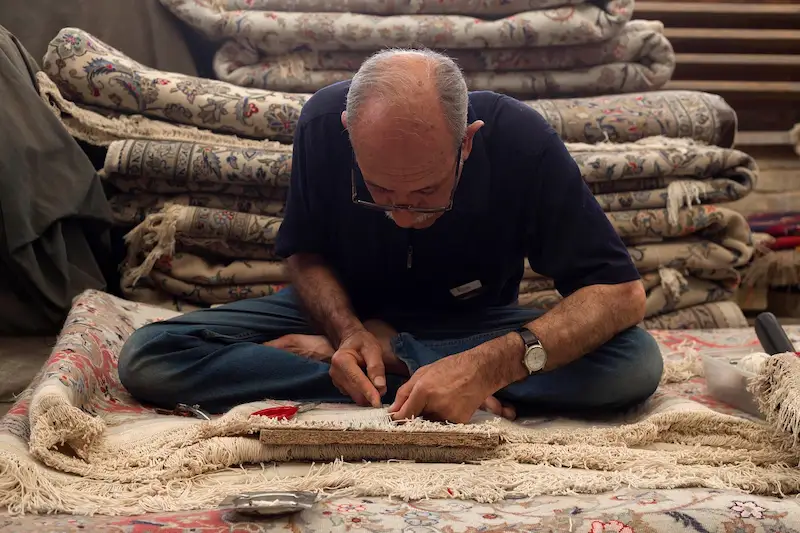A used or old carpet can have sentimental values, give character to any room, and might even be alive, so to say, if properly looked after. There is no reason to throw away your torn and worn-out carpets, since you can bring them into life with a few techniques and repairs. Learning how to restore carpets at home is economically viable and keeps your place cozier and fresher.
In this post, we’ll take you through some practical steps you can take to repair and refresh your carpets to almost new.
Table of Contents
Why Repair Old Carpets?
Cost-Effective: Repairs are often way cheaper than buying new carpets.
Eco-Friendly: This helps extend the life of your carpet, reduces waste, and is a step toward sustainability.
Preservation: Bring back the beauty to that vintage carpet or one which is irreplaceable.
Evaluating Your Carpet’s Condition
Before making the repairs, you’ll need to evaluate the extent of the damage:
Stains: Identify whether these are surface stains or set-in deep.
Tears or Holes: Record the size and placement of the rips or worn places.
Fading: One should always check for discoloration, especially around areas exposed to sunlight.
Odor: Lingering odors may require further cleaning deeper in.
Then you will know what kind of solutions you will apply for repair.
How to Fix Common Carpet Problems
1. Patches and Tears
Small Tears: Apply some carpet adhesive or use double-sided carpet tape to hold the edges together again. Press hard and let it stay that way for a couple of hours so that it firmly attaches.
Larger Holes: Cut out a matching patch from some leftover carpet or from an area that does not show. Glue it in place with strong adhesive or carpet seam tape. Smoothen the edges with a comb or your fingers to give it that seamless finish.
2. Frayed Edges
Dealing with frayed edges can make your carpet look untidy, and this will get worse with time.
Trim these loose threads with scissors carefully.
Use carpet binding tape along the edge to prevent further fraying; use a hot glue gun as an easy fix, alternatively.
3. Removing Stubborn Stains
General Stains: Blot stains lightly using water and mild dish soap.
Difficult Stains (e.g., wine, coffee): Make a paste of baking soda and vinegar on the stains. Allow the mixture to act for 10 minutes. Dip a white clean cloth in cold water and blot the area above the stain with a humid cloth.
Pet Stains: Treat the stains enzymatically.
Hint: It would be best to always try on a little place, not clearly visible.
4. Restoring Piled Carpet Fibers
Heavy furniture and high traffic can flatten carpet fibers.
Put an ice cube on the spot and let it melt. Then tease the fibers apart with a spoon or a soft brush.
Alternatively, steam using an iron at low temperature: put a cloth between the iron and carpet, steam, and comb the fibers up.
5. Repairing Fading or Discoloration
Use carpet dye kits to restore color to faded spots. These kits include dyes that can be matched to your carpet’s original shade.
For minor fading, blending with fabric markers or crayons in matching colors can work in a pinch.
How to Renew and Restore Old Carpets:
1. Deep Clean the Carpet
Deep cleaning can breathe life into an old carpet.
Rent or buy some type of carpet cleaning machine for deep-seated dirt on the carpet.
There are eco-friendly carpet shampoos that clean the carpet safely and effectively.
2. Eliminate Odors
Odors can easily be removed by just sprinkling baking soda over the carpet and leaving it overnight to do its magic.
The next morning, vacuum, and it should smell nice and fresh again.
3. Re-stretch Buckled or Wrinkled Carpets
Buckled or wrinkled carpet will need re-stretching.
Stretch and smooth the carpet with a carpet knee kicker available for rent.
Fasten it using a carpet stretcher or tack strips.
4. Add New Padding
Replacing old flattened carpet padding with new padding can make the carpet softer and more comfortable.
DIY Tools and Products You’ll Need
- Carpet adhesive or double-sided tape
- Scissors and a hot glue gun
- Carpet cleaning machine or vacuum
- Carpet dye kits or fabric markers
- Enzymatic cleaner (for pet stains)
- Baking soda and vinegar
How to Avoid Further Damage
Regular Cleaning: This will prevent dirt and debris from settling. It is recommended to vacuum at least twice a week.
Use Rug Pads: Place pads under furniture legs to prevent indentations.
Protect from Sunlight: Curtains or blinds can help reduce the amount of fading from UV rays.
Prompt Repairs: Small tears and stains should be repaired as soon as possible to prevent further deterioration.
FAQs About Repairing and Reviving
Can I repair damaged carpets at home?
As long as the carpet damage comprises only minor tears, stains, or fraying, you can do it yourself at home by following simple techniques. If the damage is more severe, such as large burns or heavy wear, consult a professional.
How do I get the patches to perfectly match?
Reutilize scraps of carpet that were left over when the carpet was installed, or cut patches out of the areas least seen, like under the furniture.
How often is my carpet supposed to be deep cleaned?
Your carpets are supposed to be deep cleaned every 6-12 months, depending on the traffic and usage they see.
Conclusion
Repairing and bringing back life to your old carpets at home is easier than you think; it saves money and keeps the charm of your interiors intact. From repairing tears to removing stubborn stains, a little effort pays off in keeping your carpet as good as new. By following these maintenance tips, you will be able to keep your carpets fresh, clean, and durable for many years to come.



